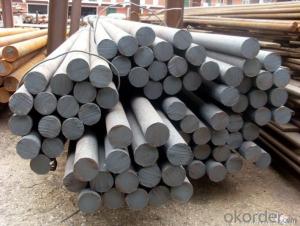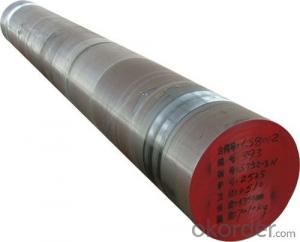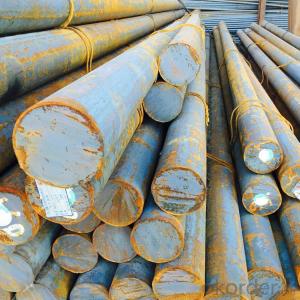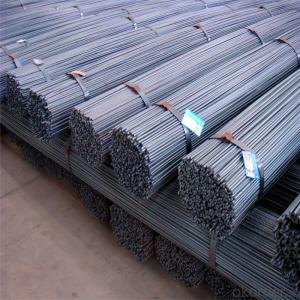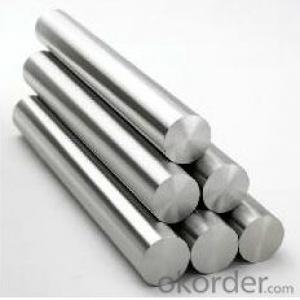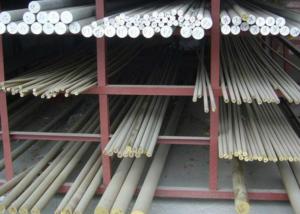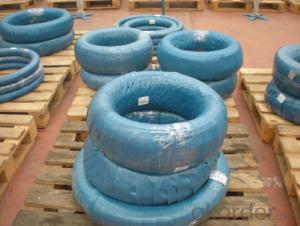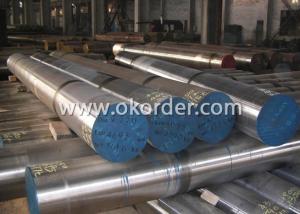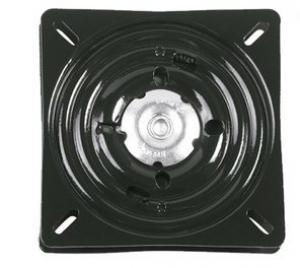SCM440 Alloy Steel Bar Hot-Rolled Bar
- Loading Port:
- Tianjin
- Payment Terms:
- TT OR LC
- Min Order Qty:
- 25 m.t.
- Supply Capability:
- 500000 m.t./month
OKorder Service Pledge
OKorder Financial Service
You Might Also Like
Item specifice
SCM440 Alloy Steel Bar Hot-Rolled Bar
Product Description:
1. Commodity: Round steel bar
3. Technical: Hot rolling
2. Length: Min. 5.8meter, according to requirement.
3. Diameter: 16mm-250mm
5. Packing: In Bundle or according to your requirements.
4. Standard: GB/T 3077-1999(42CrMo) ; JIS SCM440; DIN 42CrMo4 ; ASTM 4140 ; BS 708M40
Chemical Composition(%):
C | Si | Mn | Cr | Mo | Ni | P | S |
0.38-0.45 | 0.17-0.37 | 0.50-0.80 | 0.90-1.20 | 0.15-0.25 | ≤0.030 | ≤0.030 | ≤0.030 |
Standard:
GB | AISI | DIN | JIS | ISO |
42CrMo | 4140 | 42CrMo4 | SCM440 | 42CrMo4 |
Available Size:
Rolled round bar | φ20-120mm × L |
Forged round bar | φ130-195mm × L |
Application:used for various large-size or medium-size precision plastic mould and low melting
point alloy parts
The steel with high strength and toughness, hardenability is better also | |||||||
After conditioning treatment quenching deformation of small | |||||||
high fatigue limit and repeated impact resistance |
Quality Certificate:we can supply quality certificate
Packaging:standard seaworthy packing or as customer require
Delivery: In 7-10 days after we receive 30% deposite
Product show:
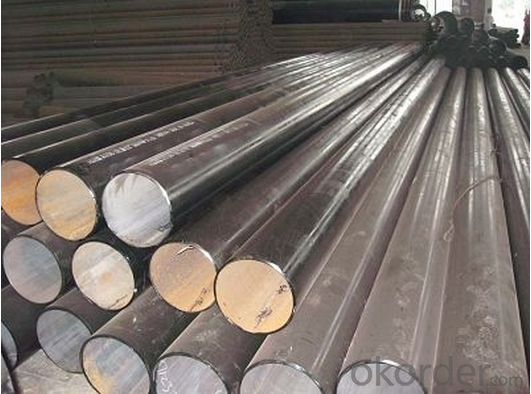
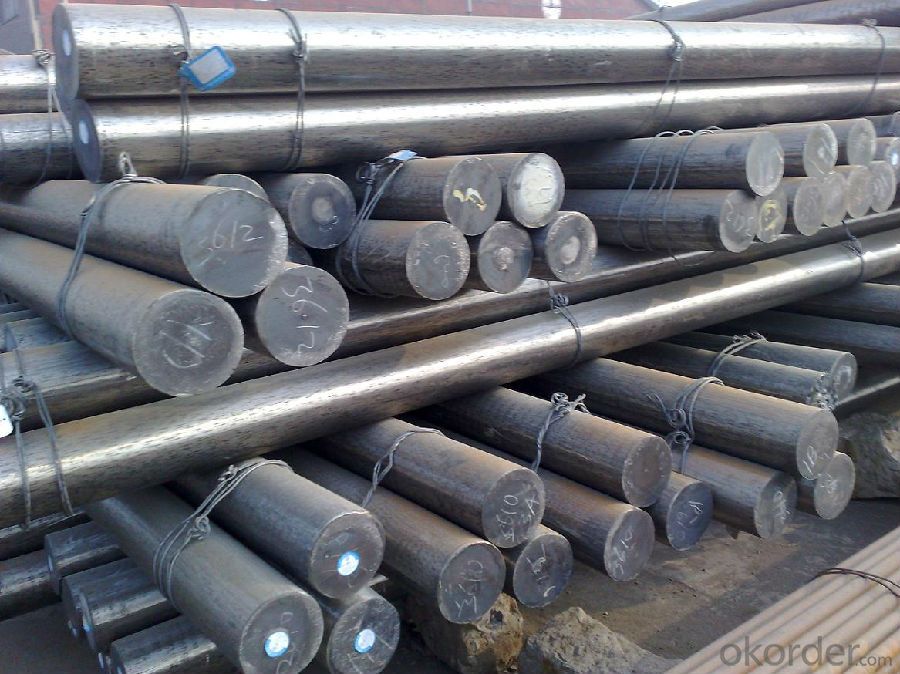
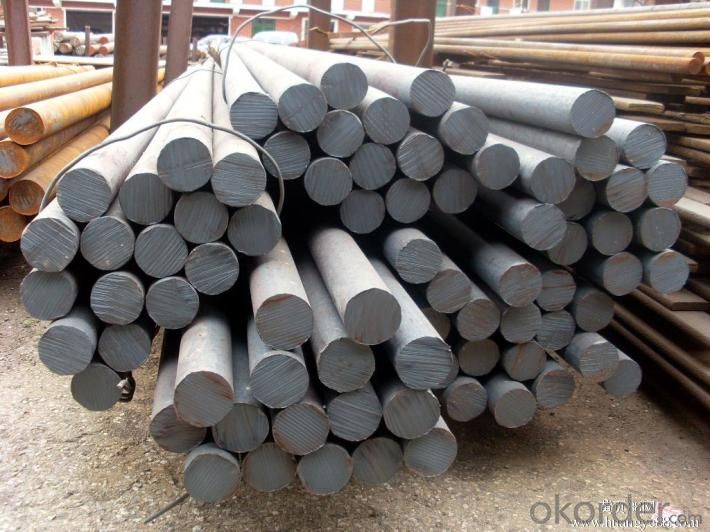
- Q:How does special steel contribute to the automotive material recycling?
- Special steel contributes to automotive material recycling in several ways. Firstly, special steel is highly durable and strong, making it ideal for use in critical automotive components such as engine parts, chassis, and suspension systems. This durability ensures that these components have a longer lifespan, reducing the frequency of replacements and minimizing waste. Additionally, special steel is highly recyclable. It can be easily melted down and reused without losing its inherent properties. This makes it an excellent choice for automakers looking to incorporate recycled materials into their production processes. By utilizing recycled special steel, the automotive industry can reduce the demand for virgin raw materials, conserve energy, and decrease greenhouse gas emissions associated with mining and production. Moreover, special steel's high strength-to-weight ratio allows for the production of lighter vehicles, enhancing fuel efficiency and reducing carbon emissions during the vehicle's operational phase. This aspect of special steel contributes to the overall sustainability of the automotive industry and supports the goals of a circular economy by promoting resource efficiency and waste reduction. Overall, special steel plays a vital role in automotive material recycling by enabling durable and long-lasting components, promoting the use of recycled materials, and contributing to the development of more sustainable and environmentally friendly vehicles.
- Q:What are the specific requirements for special steel used in the mining drill bit industry?
- The mining drill bit industry has specific requirements for the special steel it utilizes, which focus on durability, toughness, and resistance to wear and corrosion. To begin with, the steel employed in mining drill bits must possess exceptional durability to endure the harsh and demanding conditions found in the mining environment. The drill bits are exposed to high levels of impact, vibration, and stress, necessitating high strength and hardness in the steel to prevent deformation or breakage. Moreover, toughness plays a crucial role in drill bit steel as it must withstand the repetitive and intense forces encountered during drilling operations. The steel should exhibit good fracture toughness to resist crack propagation and prevent premature failure. Additionally, wear resistance is of utmost importance for drill bit steel, as it must retain its cutting edge and performance over long periods. The steel needs to have high wear resistance to withstand the abrasive nature of the rocks and minerals being drilled. Furthermore, apart from wear resistance, the steel utilized in mining drill bits must also demonstrate resistance to corrosion. The mining environment often involves exposure to water, chemicals, and various corrosive agents. Hence, the steel should possess suitable corrosion resistance properties to prevent rusting and degradation. In conclusion, the special steel employed in the mining drill bit industry must fulfill these specific requirements of durability, toughness, wear resistance, and corrosion resistance to ensure reliable and efficient drilling operations in the mining sector.
- Q:What are the different methods of surface ion nitriding for special steel?
- Surface ion nitriding of special steel can be achieved through various methods. These methods encompass: 1. Utilizing DC Plasma Nitriding: Employing direct current (DC) plasma to ionize nitrogen gas, a plasma atmosphere is created. By subjecting the special steel to the plasma chamber and applying high voltage, the ions are accelerated towards the steel's surface, resulting in nitriding. 2. Adopting RF Plasma Nitriding: Similar to DC plasma nitriding, RF (Radio Frequency) plasma nitriding employs a radio frequency power supply to generate plasma instead of direct current. This method allows for better control over the nitriding process and can accommodate more intricate geometries. 3. Employing Pulse Plasma Nitriding: By applying short pulses of high voltage to the steel surface, a plasma discharge is created. These pulses are repeated at regular intervals, enabling precise control over the nitriding process. Pulse plasma nitriding is commonly used for steels with sensitive properties that may be affected by prolonged exposure to high temperatures. 4. Combining Plasma Assisted Nitriding: This method combines plasma nitriding with other surface treatment techniques, such as physical vapor deposition (PVD) or chemical vapor deposition (CVD). Initially, the steel is coated with a thin layer of reactive material, followed by nitriding in a plasma atmosphere. This combination enhances the surface properties of the special steel, such as wear resistance or corrosion resistance. 5. Employing Glow Discharge Nitriding: This method involves placing the special steel in a chamber filled with a nitrogen-rich gas, such as ammonia. Applying high voltage creates a glow discharge, which ionizes the gas and generates nitrogen ions that diffuse into the steel's surface. Glow discharge nitriding is commonly employed for small parts or components with complex shapes. It is crucial to consider factors such as desired properties, steel geometry, and application-specific requirements when selecting the most suitable method for surface ion nitriding of special steel.
- Q:What are the common techniques for testing the quality of special steel?
- Some common techniques for testing the quality of special steel include chemical analysis, mechanical testing, non-destructive testing, and metallography. Chemical analysis involves examining the composition of the steel to ensure it meets the required specifications. Mechanical testing involves subjecting the steel to various forces and measuring its strength, hardness, and other mechanical properties. Non-destructive testing methods such as ultrasound, radiography, and magnetic particle inspection are used to detect any defects or flaws in the steel without causing damage. Metallography involves examining the microstructure of the steel under a microscope to assess its grain size, inclusion content, and overall quality. These techniques help ensure that special steel meets the necessary standards and requirements.
- Q:What are the different forming processes for special steel?
- There are several forming processes for special steel, including hot forming, cold forming, and powder metallurgy. Hot forming involves heating the steel to a high temperature and then shaping it through processes like forging or rolling. Cold forming, on the other hand, involves shaping the steel at room temperature using processes like bending or extrusion. Powder metallurgy involves compacting metal powders and then sintering them to create a solid piece. These forming processes allow for the production of special steel with unique properties and shapes to meet various industrial needs.
- Q:What are the challenges in machining high-speed special steel?
- Several challenges arise when machining high-speed special steel due to its unique properties and characteristics. Its extreme hardness presents one of the main obstacles, making cutting and shaping difficult. High-speed special steel typically has a high carbon content and undergoes heat treatment to enhance its hardness, resulting in increased wear on cutting tools. The increased hardness of this steel also leads to elevated heat generation during the machining process. This heat can cause thermal distortion and impact the dimensional accuracy of the final product. To counteract this, specialized cooling techniques and cutting tools with advanced coatings must be used to dissipate heat and maintain stability. Another challenge is the brittleness of high-speed special steel. It tends to have low toughness and is susceptible to cracking and chipping during machining operations. To minimize the risk of tool failure and excessive stress, careful selection of cutting parameters such as cutting speed, feed rate, and depth of cut is necessary. Furthermore, high-speed special steel often contains alloying elements like tungsten, vanadium, and cobalt, which can further complicate the machining process. While these elements increase the strength and wear resistance of the steel, they also make it more challenging to machine. Effective machining of these alloys and achieving desired surface finishes requires specialized tool materials and cutting strategies. Additionally, the cost of high-speed special steel is often significantly higher than that of conventional steels, adding to the challenges of machining. The high tooling costs associated with the cutting tools required for machining this steel can be a substantial investment. Overall, machining high-speed special steel necessitates advanced cutting techniques, specialized tooling, and careful consideration of cutting parameters to overcome the challenges posed by its extreme hardness, brittleness, and alloying elements.
- Q:What are the common challenges in forging special steel?
- Forging special steel poses several common challenges that manufacturers and engineers must address in order to achieve desired outcomes. One of the primary challenges in forging special steel is maintaining precise temperature control throughout the process. Special steels often have specific heat treatment requirements, and any deviation from the recommended temperature range can adversely affect the final properties of the material. Achieving and sustaining the right temperature is crucial to ensure desired mechanical properties like strength, hardness, and toughness. Another challenge in forging special steel is controlling the cooling rate during quenching. Quenching is a critical step in the heat treatment process that helps to achieve the desired hardness and strength in special steels. However, rapid cooling can lead to the formation of undesirable microstructures or even cracking. Therefore, carefully managing the cooling rate is essential to avoid these issues and ensure optimal material properties. Additionally, shaping special steels through forging can be challenging due to their high strength and hardness. These materials are often more difficult to deform compared to regular steels, requiring higher forging pressures and specialized equipment. The resistance to deformation can lead to increased wear on the forging dies, requiring frequent maintenance and replacement. Furthermore, special steels may contain alloying elements that can affect their forgeability. Some alloying elements can promote grain growth, which can reduce the mechanical properties of the material. Finding the right balance of alloying elements and optimizing the forging process parameters is crucial to achieve the desired microstructure and properties in the final product. Lastly, ensuring consistency and repeatability in the forging process can be a challenge. Special steels are often produced in smaller quantities or for specific applications, making it important to maintain process control and quality assurance. Proper documentation, monitoring, and quality control measures need to be implemented to ensure that the forged special steel meets the desired specifications and performance requirements. Overall, forging special steel requires careful attention to temperature control, cooling rate during quenching, shaping difficulties, alloying elements, and maintaining consistency. Addressing these challenges through proper process control and optimization is crucial to obtain high-quality special steel products with the desired mechanical properties and performance characteristics.
- Q:What are the different methods of improving the impact toughness of special steel?
- There are several methods for improving the impact toughness of special steel. One common method is through heat treatment processes such as quenching and tempering, which involve heating the steel to a high temperature and then rapidly cooling it. This helps to refine the grain structure of the steel, making it more resistant to cracking and improving its toughness. Another method is alloying, where specific elements are added to the steel to enhance its toughness, such as nickel, chromium, or manganese. Additionally, controlling the cooling rate during the manufacturing process, known as controlled cooling, can also improve the impact toughness of special steel by minimizing the formation of brittle phases. Overall, a combination of heat treatment, alloying, and controlled cooling can be employed to enhance the impact toughness of special steel.
- Q:Can special steel be used in the oil refinery industry?
- Yes, special steel can be used in the oil refinery industry. Special steels, such as stainless steel and duplex stainless steel, offer superior corrosion resistance and high strength properties, making them suitable for various applications in oil refineries. These steels can withstand harsh operating conditions, including exposure to corrosive chemicals and high temperatures, ensuring the durability and safety of equipment and infrastructure in the oil refinery industry.
- Q:What are the requirements for special steel used in military applications?
- In order to ensure optimal performance and durability in the field, special steel utilized in military applications must meet specific criteria. These criteria encompass: 1. Superior strength: Military applications often entail extreme conditions, including heavy loads, impacts, and shocks. To withstand these forces without deformation or failure, special steel employed in these applications must possess high strength. 2. Exceptional toughness: The steel should exhibit remarkable toughness to resist cracking or fracturing when subjected to high-stress situations. This is crucial for safeguarding the well-being of military personnel and equipment. 3. Resistance to corrosion: Military operations can occur in diverse environments, such as marine or coastal areas, where exposure to moisture, saltwater, and other corrosive elements is prevalent. To maintain its structural integrity over time, special steel employed in military applications must possess good corrosion resistance. 4. Heat resistance: Military equipment frequently encounters elevated temperatures due to friction, combustion, or exposure to explosives. The steel used must possess good heat resistance to prevent deformation or loss of strength under such conditions. 5. Wear resistance: Military equipment undergoes frequent use, abrasive contact, and potential impacts with foreign objects. Therefore, special steel employed in these applications must exhibit excellent wear resistance to minimize damage and extend the lifespan of the equipment. 6. Machinability: Special steel utilized in military applications should be easily machinable and processable into various shapes and sizes. This ensures that it can be tailored to specific requirements and seamlessly integrated into different military systems. 7. Cost-effectiveness: While meeting all the aforementioned requirements, special steel utilized in military applications should also be cost-effective. It must strike a balance between performance and cost to ensure efficient resource utilization. By fulfilling these requirements, special steel employed in military applications can deliver the necessary strength, durability, and reliability required for military operations, thereby ensuring the safety and effectiveness of military personnel and equipment.
1. Manufacturer Overview |
|
|---|---|
| Location | |
| Year Established | |
| Annual Output Value | |
| Main Markets | |
| Company Certifications | |
2. Manufacturer Certificates |
|
|---|---|
| a) Certification Name | |
| Range | |
| Reference | |
| Validity Period | |
3. Manufacturer Capability |
|
|---|---|
| a)Trade Capacity | |
| Nearest Port | |
| Export Percentage | |
| No.of Employees in Trade Department | |
| Language Spoken: | |
| b)Factory Information | |
| Factory Size: | |
| No. of Production Lines | |
| Contract Manufacturing | |
| Product Price Range | |
Send your message to us
SCM440 Alloy Steel Bar Hot-Rolled Bar
- Loading Port:
- Tianjin
- Payment Terms:
- TT OR LC
- Min Order Qty:
- 25 m.t.
- Supply Capability:
- 500000 m.t./month
OKorder Service Pledge
OKorder Financial Service
Similar products
New products
Hot products
Hot Searches
Related keywords




